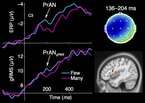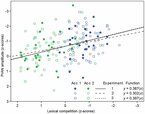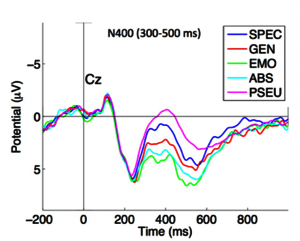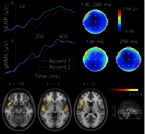Words
Pre-activation negativity (PrAN)


The pre-activation negativity (PrAN) is an electrically negative brain potential discovered in our lab. It shows the predictive strength of phonological cues. Already at word onset, PrAN has higher amplitude for word beginnings that have few possible word continuations of high lexical frequency (Söderström, Horne, Frid & Roll, 2016; Roll, Söderström, Frid, Mannfolk, & Horne, 2017).
PrAN and cohort size
The number of possible word continuations is also referred to as the word beginning's cohort size (Marslen-Wilson, 1984). Thus, word beginnings with smaller cohort sizes have a larger PrAN (Söderström et al., 2016). PrAN amplitude is also larger if the words of the cohort have high lexical frequency (Roll et al., 2017). Since PrAN is a negative component, its decrease with cohort size is positive and its increase with lexical frequency is negative:
PrAN = k (cohort size) – c (lexical frequency)
where k and c are constants.
Processing word meaning

We use words to communicate our thoughts. Words can express different kinds of concepts: specific (SPEC) concrete objects like wrench, more general (GEN) things like tools, more abstract (ABS) concepts like building, and even emotionally (EMO) colored concepts like prison. Using neurolinguistic methods, we have investigated how these different kinds of words are processed and how their meanings are related to various linguistic and cognitive parameters (Blomberg, Roll, Lindgren, Brännström, and Horne, 2015). The ERP N400 component is one way of getting a better understanding of how these different factors interact when we process words and we have found e.g. that the greater the number of discourse related semantic neighbors a word has, the lower its N400 is. General words like tool have relatively many semantic neighbors, whereas more specific words like wrench have relatively fewer such neighbors, and pseudowords (PSEU) have none. Another factor that leads to lowering the N400 is a relatively high level of emotional arousal, whereas a relatively large number of orthographic neighbors has the opposite effect (Blomberg, Roll, Frid, Lindgren, and Horne, 2020).
When the brain suffers a lesion, due e.g. to stroke, the way words are processed can be drastically hampered. We have seen that if the visual cortex receives a lesion, it becomes difficult for speakers to understand concrete words like wrench whose meaning crucially involves being able to process visually related semantic information about shape and color (Mårtensson, Roll, Lindgren, Apt, & Horne, 2014). Abstract words on the other hand can still be understood and produced since they do not rely on being able to process visual meaning components to the same degree (Roll, Mårtensson, Sikström, Apt, Arnling-Bååth, & Horne, 2012).
Word accents


Swedish and Norwegian "word accents" consist of a high or a low tone on a word stem. The stem tone, however, is induced mainly by the word's suffix (Riad, 2014; Rischel, 1963). Thus, the stem hatt 'hat' is pronounced with a low tone (accent 1) in hatt+en 'hat+the,' but the plural suffix -ar induces a high tone (accent 2) onto the stem in hatt+ar 'hat+s.' The same melody change is found in all words with this variation: båten/båtar 'the boat/boats,' bussen/bussar 'the bus/buses' etc. Swedish word accents are often assumed to have low "functional load," since the contrast between word accents is hardly ever used to differentiate between words. However, we have found that, just like left-edge boundary tones that lead listeners to expect a certain sentence structure, word accents lead listeners to expect a particular word structure. Thus, a suffix that has been invalidly cued by the wrong word accent produces a P600, showing that the word structure needs to be reanalyzed (Roll, Horne, & Lindgren, 2010; Roll, Söderström, & Horne, 2013; Roll, 2015; Roll, Söderström, Shtyrov, Mannfolk, Johansson, van Westen, & Horne, 2015; Söderström, Horne, & Roll, 2017; Söderström, Horne, Mannfolk, van Westen, & Roll, 2018). Word accents even produce a pre-activation negativity (PrAN), showing how they pre-activate the ending of words (Roll, 2015; Söderström et al., 2016), possibly originating in Wernicke's and Broca's areas (Roll, et al., 2015; Söderström et al., 2018). We suggest that the main function of word accents might be the predictive rather than the distinctive function. Word accents make processing of their associated suffixes quicker (Söderström, Roll, & Horne, 2012), and a thicker cortex in Wernicke's area speeds up processing of the connection between word accent and suffix (Schremm, Novén, Horne, Söderström, van Westen, & Roll, 2018).
